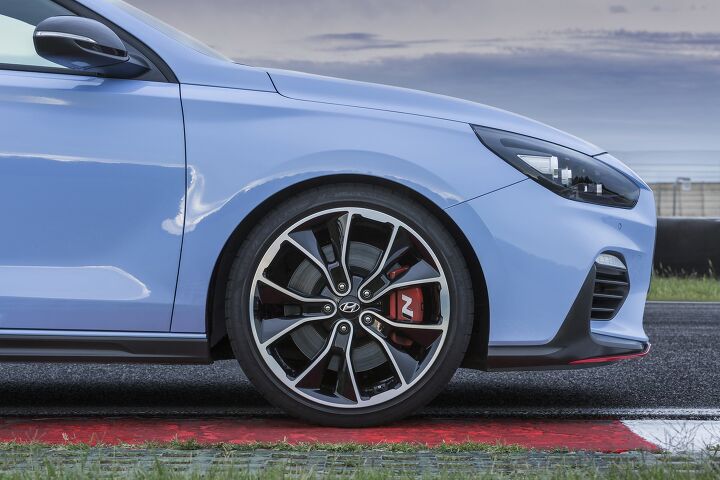Hyundai Delivers a Hotter Hatchback With the I30 N

After four years of development, Hyundai is ushering a new entry into the hot hatchback category with its i30 N. Based on the newest incarnation of the family friendly i30, known throughout North America as the Elantra GT, the N badge separates it as a serious performance model. Hyundai appears to be taking direct aim at the Ford Focus ST and Volkswagen GTI, both through the N’s performance and styling — which seems to be a handsome amalgamation of the pair.
Available in two trims, the base model i30 N provides 246 horsepower while the performance package quipped version bumps that number up to 271 hp. Both use a turbocharged 2.0-liter and six-speed manual transmission and, according to Hyundai, can manage 0-60 times in the low six-second range. Power is sent to the front tires and only to the front tires, with an electronic limited slip differential to keep things manageable in the corners.
It’s a legitimate hot hatch and Hyundai’s first if you discount the Veloster — which you definitely may.
Hyundai seems proud of the technical aspects of the i30 N but claims it wants to focus on a fun car more than anything else. It’s a recipe it hopes to replicate on more models in the future. “The Hyundai i30 N has been developed for no other purpose than to deliver maximum driving fun to our customers in an accessible high-performance package,” explained Albert Biermann, executive vice president of the brand’s performance group. “With the high-performance N models we will enhance our brand’s appeal with emotional products that cater to the needs of people who love to have a smile on their face when they drive their car on a winding road and listen to the sound of the engine.”
The automaker exerted some extra effort on the i30’s variable exhaust valve system’s sound and filled the interior with things like track timers and g-force meters — wholly unnecessary but welcome in something that is supposed to evoke a sensation of sportiness.
There are five selectable driving modes, including Eco, Normal, Sport, N and N Custom. The settings adjust the ferocity of the engine, stability control, electronic differential, steering input, enhanced exhaust sounds, the rev matching. Hyundai also wanted to be clear that stability control could be shut off completely for those interested in “maximum freedom.”
It also comes with Apple CarPlay, Android Auto, and a wireless charging pad for phones. Hyundai also saw fit to toss in a seven-year subscription to Hyundai LIVE — making weather and navigation easily accessible through the car’s 8-inch touchscreen. Safety assists like autonomous emergency braking, lane-keeping, and traffic sign recognition are also standard on the i30 N.
The interior receives elements not found on any other Hyundai. There is a model-specific steering wheel, gearshift knob, high-bolstered sport seats and loads of N logos.
Why exactly Hyundai chose to use the N as a performance demarkation is a bit of a mystery. The automaker claims its shape resembles a chicane and the i30 was tested relentlessly at the Nürburgring circuit, but were (wisely) unwilling to call it a “Nürburgring Edition.” In truth, the brand probably just needed something to that would easily differentiate its performance models and couldn’t call them Type Rs for obvious legal reasons.
Slated to arrive in Europe by the end of 2017, the i30 N’s future in North America is unknown. Hyundai doesn’t appear to have any plans for this continent, where the model would undoubtedly carry an Elantra GT moniker, but hinted that another N car would eventually make an appearance. Based upon some earlier hinting, our best guess is that it’ll be the Veloster — which would only benefit from some beefed-up internals.
[Images: Hyundai]

A staunch consumer advocate tracking industry trends and regulation. Before joining TTAC, Matt spent a decade working for marketing and research firms based in NYC. Clients included several of the world’s largest automakers, global tire brands, and aftermarket part suppliers. Dissatisfied with the corporate world and resentful of having to wear suits everyday, he pivoted to writing about cars. Since then, that man has become an ardent supporter of the right-to-repair movement, been interviewed on the auto industry by national radio broadcasts, driven more rental cars than anyone ever should, participated in amateur rallying events, and received the requisite minimum training as sanctioned by the SCCA. Handy with a wrench, Matt grew up surrounded by Detroit auto workers and managed to get a pizza delivery job before he was legally eligible. He later found himself driving box trucks through Manhattan, guaranteeing future sympathy for actual truckers. He continues to conduct research pertaining to the automotive sector as an independent contractor and has since moved back to his native Michigan, closer to where the cars are born. A contrarian, Matt claims to prefer understeer — stating that front and all-wheel drive vehicles cater best to his driving style.
More by Matt Posky
Latest Car Reviews
Read moreLatest Product Reviews
Read moreRecent Comments
- ToolGuy First picture: I realize that opinions vary on the height of modern trucks, but that entry door on the building is 80 inches tall and hits just below the headlights. Does anyone really believe this is reasonable?Second picture: I do not believe that is a good parking spot to be able to access the bed storage. More specifically, how do you plan to unload topsoil with the truck parked like that? Maybe you kids are taller than me.
- ToolGuy The other day I attempted to check the engine oil in one of my old embarrassing vehicles and I guess the red shop towel I used wasn't genuine Snap-on (lots of counterfeits floating around) plus my driveway isn't completely level and long story short, the engine seized 3 minutes later.No more used cars for me, and nothing but dealer service from here on in (the journalists were right).
- Doughboy Wow, Merc knocks it out of the park with their naming convention… again. /s
- Doughboy I’ve seen car bras before, but never car beards. ZZ Top would be proud.
- Bkojote Allright, actual person who knows trucks here, the article gets it a bit wrong.First off, the Maverick is not at all comparable to a Tacoma just because they're both Hybrids. Or lemme be blunt, the butch-est non-hybrid Maverick Tremor is suitable for 2/10 difficulty trails, a Trailhunter is for about 5/10 or maybe 6/10, just about the upper end of any stock vehicle you're buying from the factory. Aside from a Sasquatch Bronco or Rubicon Jeep Wrangler you're looking at something you're towing back if you want more capability (or perhaps something you /wish/ you were towing back.)Now, where the real world difference should play out is on the trail, where a lot of low speed crawling usually saps efficiency, especially when loaded to the gills. Real world MPG from a 4Runner is about 12-13mpg, So if this loaded-with-overlander-catalog Trailhunter is still pulling in the 20's - or even 18-19, that's a massive improvement.






































Comments
Join the conversation
Love it other than the red exterior accents and the fact it's manual only. There should be a law somewhere that all non-electrified cars must offer both an automatic and manual, something for everyone. Also I'm ok with Hondas or Mazdas being manual-only since those manufacturers are known for their prowess in that area. Hyundai is not.
*LOVE* the i30N! And love the fact that it's offered with a manual tranny. But why not bring it to North America? I would certainly consider buying this but never look at the Veloster because it's impractical.